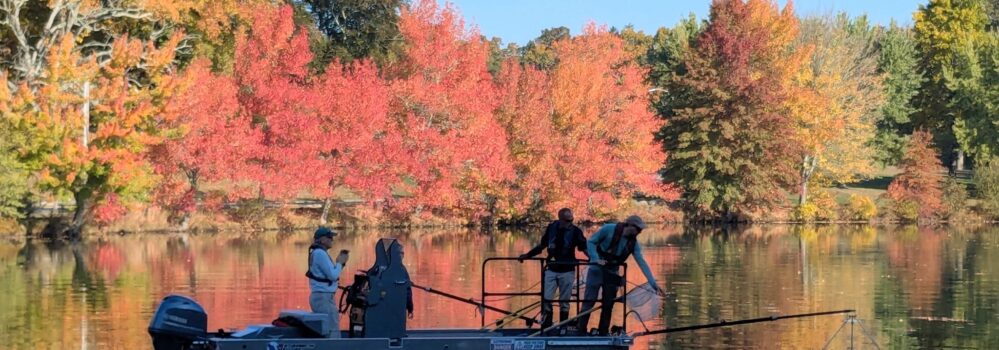
From Gray to Green: How Southeastern New England Nonprofits Are Revitalizing Urban Watersheds
Thanks to the SNEP Watershed Implementation Grant Program, organizations clean up their communities while investing in job training, more resilient infrastructure, and Providence’s future.
February 10, 2025
By: Brad Williamson
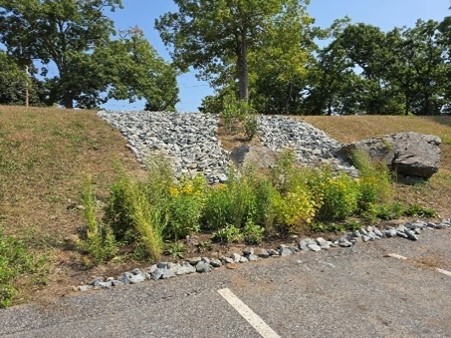
Across the country, municipalities, counties, businesses, and homeowners are realizing the benefits of “green infrastructure” in place of traditional “gray infrastructure” for stormwater management. For the past several decades, gray infrastructure – stormwater management systems built out of concrete (i.e., pipes, tunnels, culverts)- has dominated urban planning and design. According to the EPA’s 2022 Clean Watershed Needs Survey, the United States will require $115 billion in future stormwater investment needs to address our aging infrastructure. But as the climate continues to warm and sea levels rise, some are starting to reexamine what communities can do to improve resiliency while simultaneously enhancing the health of community members.
“I think it’s important because it can be the cheaper option. It’s cheaper than redoing all of the gray infrastructure and also provides all of these, secondary benefits of pollinator plants, creating habitat, creating beautification if it’s done right,” said Ryan Kopp, Stormwater Innovation Center Director. “Having a balance of both, I think is important.”
In 2012, at the direction of Congress, the U.S. Environmental Protection Agency (EPA) created the Southeast New England Program (SNEP) to restore and protect the region’s coastal waters and watersheds. SNEP works in partnership with stakeholders in Massachusetts and Rhode Island to promote a resilient ecosystem of clean water, healthy, diverse habitats, and sustainable communities in Southeast New England.
To help restore clean water and healthy ecosystems to Southeast New England, Restore America’s Estuaries launched the SNEP Watershed Implementation Grants (SWIG). With financial support from the EPA, the grants target water pollution, habitat degradation, and other high-priority issues that threaten the health and economic well-being of coastal Southeast New England. Since its inception, SWIG grants have funded dozens of projects throughout the region, including three in the Providence area.
SNEP/SWIG Grantee: Groundwork Rhode Island
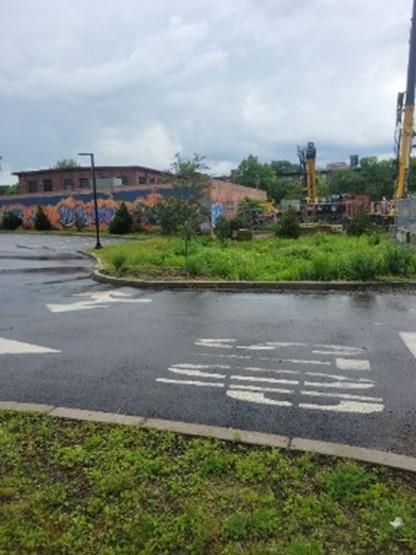
Situated at the northernmost end of Narragansett Bay, where the Providence and Seekonk Rivers converge, Groundwork Rhode Island works to keep estuaries and bays healthy through projects that take place miles inland from the coastline. Driven by a desire to improve both the physical and economic health of urban communities, Groundwork Rhode Island was founded as a community-led nonprofit organization that connects residents with their greenspaces through job training, employment, and social venture programs.
Groundwork Rhode Island identified several areas for stormwater improvement throughout Pawtucket and Central Falls and selected three locations for new swales and rain gardens. Funded by the EPA Southeast New England Program (SNEP) Watershed Implementation Grant (SWIG), these swales and rain gardens were placed at three nonprofit locations: the Boys & Girls Club of Pawtucket, Heritage Park YMCA, and Fuerza Laboral.
“We’ve been able to use this SNEP funding to dream up new projects and figure out pathways and new things that we want to create for new initiatives that allow us to employ more people and expand the work we’ve already been doing,” said Amelia Rose, Groundwork Rhode Island Executive Director. “We need both gray and green infrastructure. Green infrastructure needs to be replicated again and again.”
These swales and rain gardens reduce flood risk by absorbing water that cannot permeate gray infrastructure, serving as valuable tools in a city’s stormwater management plan while also benefiting the local ecosystem. They effectively remove pollutants from runoff and capture sediment from upstream sources, reducing erosion. When properly designed and implemented, they often cost less to maintain than other infrastructure, saving municipalities money in the long run.
Workforce Development
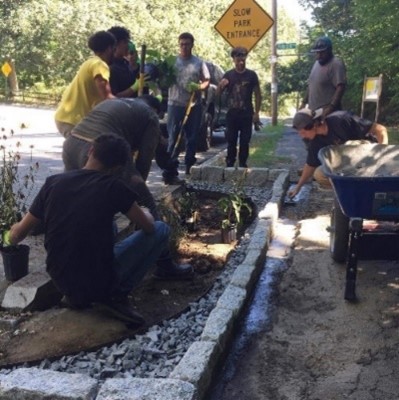
In addition to funding the implementation of the physical infrastructure, the SWIG funds were put to use providing job training and teaching valuable skills that can be put to use on future projects.
“We have our job training program and that’s an educational piece. And we visit the wastewater treatment facilities and we do stormwater projects,” said Rose. “We learn about it in the classroom and then we do hands-on work out in the field and the student are very engaged and then we figure out ways to connect people with jobs, either with us or with another employer.”
But with all things, funding is limited and does not allow for the future maintenance of the projects meaning that the infrastructure must be built to last.
“That’s why we’re excited about the grant because it is focused on job training and workforce development. That’s sort of our way of doing maintenance, but also employing people and doing some new stormwater projects as well,” said Rose.
Looking Ahead
Cities throughout Rhode Island recognize that as flooding continues to impact homes and businesses along the coast, changes must be made to stormwater management plans. That’s why Groundwork Rhode Island emphasizes educating the public on the benefits of green infrastructure.
“It strengthens the community, improves mental health, and makes people happier—just a few of the many reasons why green spaces are important,” said Rose.
By prioritizing education, community engagement, and innovative green infrastructure solutions, Groundwork Rhode Island is building more resilient urban spaces and inspiring a sustainable future for communities across the region.
SNEP/SWIG Grantee: Woonasquatucket River Watershed Council
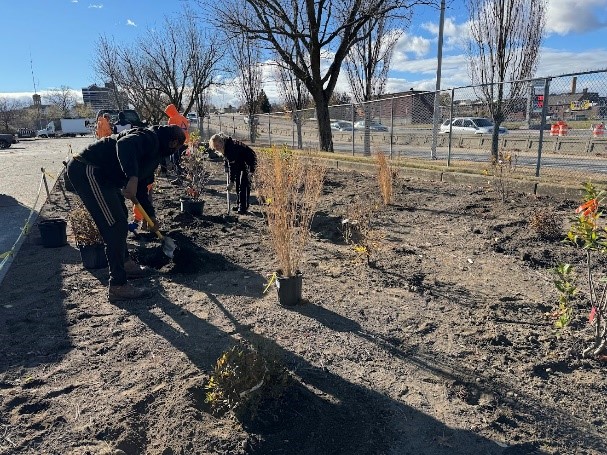
The Woonasquatucket River snakes through downtown Providence, past businesses, homes, and even through the Providence Place Mall. Rhode Islanders pass by it every day, utilizing the miles of greenspace that run alongside the river for biking, walking, running, or playing. But rarely do they stop and think about the health of the river or what it would mean if it became too polluted to enjoy. That’s where the Woonasquatucket River Watershed Council steps in.
The Woonasquatucket River Watershed Council was formed to spark economic development through its work restoring the Woonasquatucket River and the communities around it, and by enhancing, extending, and attracting people to the Woonasquatucket River Greenway. To support these efforts, the Council first applied for and received a SWIG grant in 2019 to conduct nature-based stormwater improvement around Providence.
Community Engagement
The implementation of these projects cannot be done without buy-in from the community, who are consulted throughout the process about the impact and design. Thankfully, the local response to the projects has been resounding.
“[Nature-based stormwater solutions] have so many multiple benefits, including clean water, creating pollinator habitat, holding back some of the water, creating infiltration for flood resilience, and employing a local workforce,” said Alicia Lehrer, Executive Director of the Woonasquatucket River Watershed Council.
“There are just so many benefits that when people hear about them, they get really excited. They want to be involved, they want to build more of them, and they look great. They really make the community feel like a nicer place to be.”

The Woonasquatucket River Watershed Council received its first SWIG grant in 2019 but has been awarded grants in subsequent rounds. Thanks to the initial funding through SWIG, they were able to grow their capacity and take on additional projects that could be funded with outside dollars.
“The work that we started then is continuing wholeheartedly today through other funding sources,” said Lehrer. “Setting that precedent has made the difference in being able to create that pipeline.”
Outside of the greenway, the Council is helping to educate the community and landowners about the benefits of implementing green infrastructure on their land. Because large impermeable parking lots surround businesses and funnel water into the stormwater system, these businesses are ideal locations for green infrastructure projects that can have an outsized impact.
One such project was finalized in late 2023 in partnership with Groundwork Rhode Island at the Providence Journal Bulletin printing facility on Kinsley Avenue, directly adjacent to the Woonasquatucket River.
Looking Ahead
The Woonasquatucket River remains a vital greenspace for Providence, but as the urban area develops, the importance of a stormwater management system that integrates green infrastructure grows. “The pilot project we did with SNEP/SWIG is just the beginning—we probably need to implement around 500 similar projects to make a real impact,” says Lehrer. Every little bit helps, and the Woonasquatucket River Watershed Council is doing its part to educate, protect, and enrich the community for future generations.
SNEP/SWIG Grantee: Stormwater Innovation Center

Spanning over 435 acres of lush greenspace and serene ponds, Roger Williams Park provides Providence residents with an outdoor retreat to connect with nature. Home to the Roger Williams Park Zoo, the park offers numerous benefits to both visitors and the surrounding environment. Over the last century, the park and its surrounding areas have changed dramatically due to urban development, requiring the city to adapt its management strategies. In 1982, three of the park’s ponds were dredged in an attempt to improve water quality, but phosphorus-laden stormwater and road sand continued to flow directly into them.
In 2017, the Rhode Island Department of Environmental Management (RIDEM) and the City of Providence entered an agreement to address the park’s ongoing water quality issues—leading to the creation of the Stormwater Innovation Center (SIC). Since its inception, SIC has led research on green infrastructure, provided professional training, and engaged the community in science-based programs to comprehensively tackle stormwater challenges.
Community Scientists

The science and engineering behind green infrastructure are constantly evolving as the climate changes and new methods become available. Since installing green infrastructure projects in Roger Williams Park several years ago, SIC has been monitoring and refining these sites to enhance their effectiveness while reducing maintenance needs.
With support from SWIG funding, SIC is enlisting volunteers to actively participate in stormwater monitoring through RainSnap.org. By uploading photos and videos of green infrastructure during storms, community members help assess the functionality of these systems. Increased public engagement leads to more effective stormwater solutions, reduced flooding, and improved water quality.
“We feel like that’s what Rain Snap does is it provides these photos and videos that help decision makers make better decisions,” said Ryan Kopp, Stormwater Innovation Center Director. “Involving the community around the park and the neighbors, that’s pretty important.”
Continuing Education
Stormwater management techniques are not traditionally part of an elementary school curriculum, but in the Providence metro-area, the connection between water and human activity starts early. SIC runs stormwater programs in five Providence community schools and collaborates with other metro-area schools to incorporate water quality lessons into their classes.
In past years, students have painted rain barrels and designed murals placed throughout the city. These field trips provide a hands-on experience, helping students understand how water moves through urban environments.
“You see the students and by the end of the class, they really get why stormwater is a problem. They see why their pet waste is a problem, why trash is a problem. So, I think long term that’s going to make a big difference,” said Kopp.

Students aren’t the only ones learning about stormwater management. In Roger Williams Park, SIC has placed educational signage and developed a self-guided tour brochure to help visitors explore different green infrastructure sites.
“We also hold an annual art and science festival called the Rain Harvest Festival. We invite people and nonprofits that are working on water quality related projects to come and set up a table. We also incorporate a lot of music, a lot of poetry, a lot of storytelling, but all with this focus on water,” said Kopp.
The goal of this community outreach is to remind property owners that even small-scale efforts can have a significant impact. “It might not seem like a lot with one property, but if you add them all up, they can make a pretty big difference in stormwater runoff,” said Kopp.
Forging New Partnerships
SWIG funding enables organizations to expand their reach while also connecting them to the SNEP network—a coalition dedicated to stormwater management, watershed restoration, and climate resilience in Rhode Island and Massachusetts.

As extreme weather becomes more frequent, collaboration between organizations has become essential. One inch rain events that used to occur once a year now happen every two weeks. When SIC began planning a stormwater management project for the Providence Zoo, they formed a timely partnership with the Buzzards Bay Coalition conducting similar work at Buttonwood Park Zoo in New Bedford, Massachusetts.
“I think definitely the networking potential of all the other organizations that receive funding or want to receive funding, being able to make connections with them, learn about their projects that they’re working on, and finding ways to collaborate is great,” said Kopp.
In partnership with the City of Providence and the Parks Department, and with continued SWIG funding, 2025 will bring both challenges and opportunities as Providence adapts to a changing climate.
